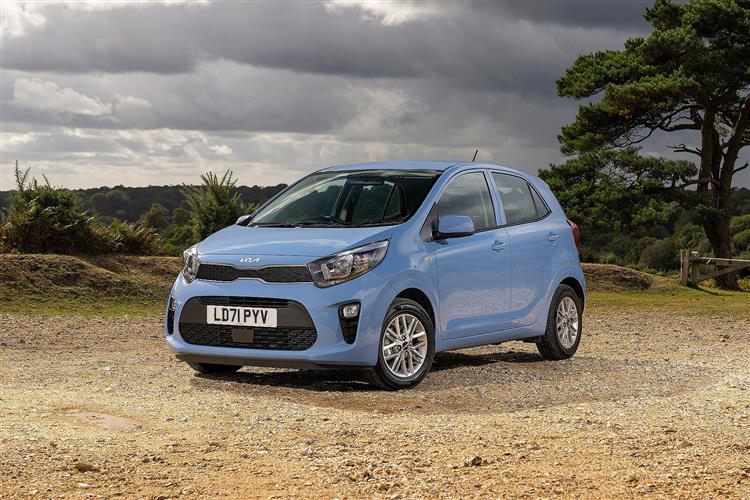PICKING A WINNER (some text hidden) --NONE--
By Jonathan Crouch
Introductionword count: 56
In third generation form launched in 2017, Kia's Picanto became a little city car with much bigger ideas. A glance at the styling and the mainstream engine line-up might not suggest that much dramatic change took place with this JA-series design but don't be deceived. A fundamental re-design transformed the kind of car this could be.
Modelsword count: 8
5DR HATCH (1.0, 1.0 T-GDI TURBO, 1.2 [GT-LINE])
Historyword count: 422
Here's how we used to understand small car categorisation and the difference between Fiesta-sized superminis and their smaller, cheaper city car counterparts. You paid extra for a supermini because it was slightly bigger, because it was better finished and more stylish and because it had more refined engines that made possible longer journeys. So where does that kind of thinking leave us with a product like this, the third generation Kia Picanto? It competed with the kinds of models we'd see as city cars, yet like many of them now, it boasted the kind of interior space a supposedly bigger Fiesta or a Corsa had until not long ago. It was very nicely built and acceptably stylish. And yes, it's quite at home attempting longer journeys. Here then, was the city car, all grown-up. The Picanto model line dates back to 2004 when in first generation form, it helped to establish the now-accepted template for the kind of more mature, capable city car that we've just been describing, one that the European makers took years to subsequently copy. The MK2 model Picanto announced in 2011 added an extra dash of style and quality to the equation but by then, the opposition was catching up and by the time that this third generation model was launched here in the early Summer of 2017, it was clear that another big step forward was going to be needed. That is exactly what was delivered. This JA-series design was still small - which is what buyers wanted - but a longer wheelbase made it bigger inside and delivered a larger boot. There was more assertive styling, a classier interior and stronger standards of safety and media connectivity. Perhaps most importantly though, there was more of a supermini-style driving experience thanks to a lighter, stiffer body structure, improved refinement and the option of a sophisticated 1.0-litre T-GDI turbo petrol engine at the top of the range. As usual with Kia, all the engineering was shared with a related Hyundai model (the i10), but the Picanto delivered it with a longer 7-year warranty that was a major factor in making this car Kia's fourth best selling global model. In 2018, an 'X-Line' version with SUV-like styling was launched, as was a perkier 1.0 T-GDi turbo version of the 1.0-litre engine (only available with sporty 'GT-Line' trim). In 2020, the 1.2-litre engine was discontinued. The MK3 Picanto sold in this form until mid-2023 when it was heavily facelifted. It's the pre-facelift 2017-2023-era models though, that we look at here.
What You Getword count: 385
“This Picanto's small”, says Gregory Guillaume, the Korean maker's Head of European Design at this JA model's launch, "but someone forgot to tell it that". We know what he means. At around 3.6m long and around 1.6m wide, the third generation version of this model shared exactly the same dimensions as its predecessor, which meant it certainly still qualifies as one of the tiniest cars you can buy from this period. At the same time though, changes to the wheelbase and the rear overhang here created significantly more space inside. Certainly, this cabin punches well above its price point, providing you can afford to stretch beyond the cheaper trim levels. It's all a long way from the not too distant days when interiors across the citycar segment had all the stylistic appeal of a telephone box. True, some of the plastics used are still a little hard to the touch, but you'd expect that in a city car and anyway, everything's so nicely integrated that you don't really notice, the unusual vertical vents bookmarking either end of the fascia and the dashboard divided into upper and lower sections by a satin chrome strip. As for infotainment, well it's a case of two extremes. Unless you stretch to pricey level '3' trim or flagship 'GT Line S' spec, you don't even get a DAB radio. But if you can buy in at the top of the range, you get as standard a class-leadingly sophisticated media set-up able to put rivals to shame; a 7-inch touchscreen which sits proud of the top of the dash, just like the monitor would in a BMW or a Mercedes. At the rear, you'll find a decent level of roominess for this class of car, providing you stick with the carriage of just a couple of adults. Finally, let's consider the boot, the size of which was increased courtesy of a 10mm increase in the length of the rear overhang. That doesn't sound much but what was delivered here was quite a big step forward from what was on offer before. Raise the light, upright tailgate and a 255-litre cargo bay is revealed. That's 55-litres more than the previous generation Picanto model could provide and the space can be accessed via a loading lip that's 55-litres lower than it was before.
To see the full road test text contact us on 0330 0020 227
Pictures (high res disabled)

.jpg)
|
.jpg)
|
.jpg)
| |||
.jpg)
|
.jpg)
|
.jpg)
| |||
.jpg)
|
.jpg)
|
.jpg)
| |||
.jpg)
|

|
Scoring (subset of scores)
Category: Small Runabouts
| Performance | |
| Handling | |
| Comfort | |
| Space | |
| Styling, Build, Value, Equipment, Depreciation, Handling, Insurance and Total scores are available with our full data feed. | |



